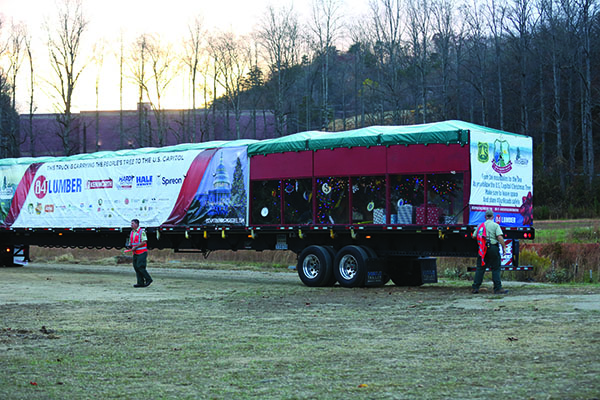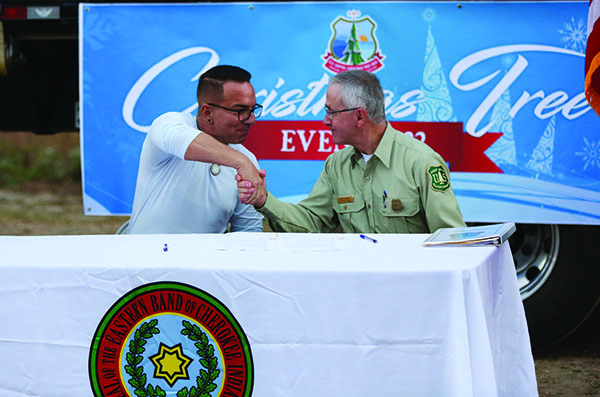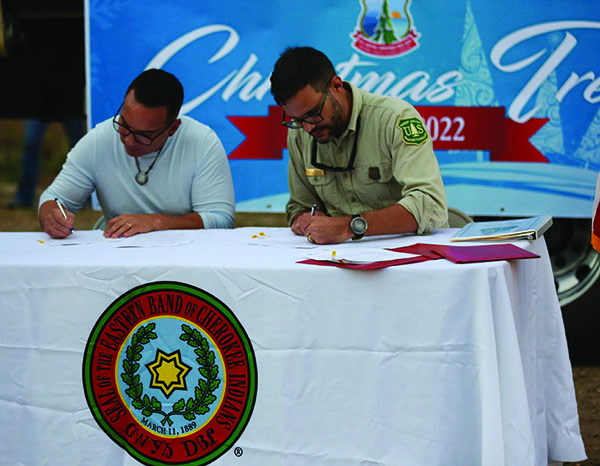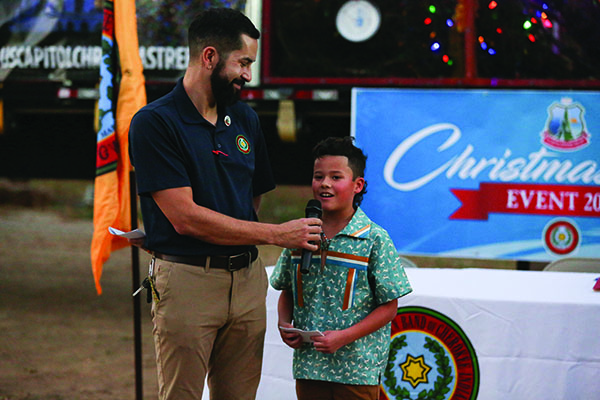
The Capitol Christmas Tree pulls into the old Cherokee Elementary School site in Cherokee, N.C. on the evening of Sunday, Nov. 6. (SCOTT MCKIE B.P./One Feather photos)
By SCOTT MCKIE B.P.
One Feather Asst. Editor
CHEROKEE, N.C. – This year’s Capitol Christmas came to Cherokee, N.C. on the evening of Sunday, Nov. 6, and the event saw the signing of two landmarks agreements between the Eastern Band of Cherokee Indians (EBCI) and the U.S. Forest Service. The tree itself is a 78-foot red spruce from the Pisgah National Forest and is scheduled to make many stops along the way to being delivered to the West Lawn of the U.S. Capitol Building on Friday, Nov. 18.

Principal Chief Richard G. Sneed, left, shakes hands with Ken Arney, U.S. Forest Service Southern Region regional forester, after they signed a Tribal Forest Protection Act agreement.
“Today is an historic day for Cherokee on two different fronts,” said Principal Chief Richard G. Sneed as he addressed the large crowd gathered for the event. “First, the beautiful U.S. Capital Christmas tree was harvested from the Pisgah National Forest, a forest that is part of the traditional and aboriginal homelands of the Cherokee Indians. As a tribe, we are honored to be a part of this ceremony and the procession route for the Capital Christmas tree.”
The EBCI and U.S. Forest Service signed a Tribal Forest Protection Act (TFPA) agreement which Chief Sneed said will include restoration on 500 to 1,000 acres of tribal trust lands annually from FY23 through FY28 in the forms of controlled burns, treating invasive species, and a targeted 50 acres of treatment for white oak harvesting for basketry.
Chief Sneed said, “This act is a co-stewardship agreement between the Eastern Band and the U.S. Forest Service that will focus on restoring forested ecosystems to be resilient now and for generations to come. Stewardship over natural resources is what our people have always done. As the original people of the region, we have a connection to the land and its resources that goes back to time immemorial. The input and stewardship of our people will ensure that resources like white oak for basketmaking and medicinal plants will be protected, managed, and maintained for use by future generations of Cherokees.”

Chief Sneed and James Melonas, U.S. Forest Service deputy forest supervisor of the National Forests in North Carolina, sign a Good Neighbor Agreement.
He added, “This agreement demonstrates what can be accomplished when government agencies work in cooperation with tribal nations to inform best practices while simultaneously respecting the knowledge and ancient traditions of Native people.”
Ken Arney, U.S. Forest Service Southern Region regional forester, signed the agreement on behalf of the U.S. Forest Service. “This is really a special time to, first, honor the Capitol Christmas tree, but also recognize the relationship between the U.S. Forest Service and the Eastern Band of Cherokee Indians. In particular, around the Tribal Forest Protection Act proposal and the signing of a Tribal Good Neighbor agreement to carry out the TFPA proposed actions.”
Speaking of the TFPA, he noted it will be the first of its kind in the Southern Region. “The Tribal Forest Protection Act was passed in July 2004 in response to the devastating wildfires that crossed from federal lands onto tribal lands that prior summer. The Act provides a tool for tribes to propose work and enter into contracts and agreements with the Forest Service to reduce threats from the federal lands adjacent to Indian trust lands and Indian communities.”
Arney went on to say, “As a federal agency, the U.S. Forest Service has a responsibility to include and honor contributions of tribal nations to the process every step of the way. As a senior official for the Forest Service, I’m deeply committed to the allyship and friendship that has been crafted between the Eastern Band of Cherokee Indians and the U.S. Forest Service personnel.”
“It is engagement and commitment such as this that allows us to manage the landscapes that we’re all so proud of and have mutual responsibility for. I believe we can best serve our obligations by continuing to build lasting relationships through discussions and actions. I look forward to continuing this collaboration and partnership with the Eastern Band of Cherokee Indians.”
Just after signing the agreement, Chief Sneed said, “Once again, the Eastern Band is leading the way and blazing new trails for other tribal nations to follow, but we could not have done so without the cooperation and support of the U.S. Forest Service.”

Joey Owle, EBCI secretary of agriculture and natural resources, left, holds the microphone for Catcuce Micco Tiger, a member of the Eastern Band of Cherokee Indians who has been selected to be official lighter of the Capitol Christmas Tree in Washington, D.C.
Information from the USFS states, “Managing fire and white oak are important elements of Cherokee relationships with forests in the southern Appalachians. Settlement, logging, and fire exclusion have altered forests and impacted culturally important forest products and practices. Integrating artisan and traditional ecological knowledge with silvicultural and fire research will inform forest management. Planned work includes prescribed fire, treating non-native and invasive species, and managing species and places valued by tribal members.”
In addition to the TFPA Agreement, the EBCI and the U.S. Forest Service entered into a Good Neighbor Agreement. James Melonas, U.S. Forest Service deputy forest supervisor of the National Forests in North Carolina, who signed on behalf of the U.S. Forest Service, said, “We are so grateful to have the relationship that we do with the Eastern Band in working together in co-stewardship on these important lands that we have the privilege to manage. The Tribal Forest Protection Act that we signed and then the Good Neighbor Agreement that we’re about to sign are tangible ways that we are working together to do good work on the ground that is important for the restoration of the ecosystem, but more importantly, the connection to the land that people have. There’s no place that has a deeper connection than here with the Eastern Band of Cherokee.”
He further noted, “I’m excited to see where we go with all the good work on the ground. The hard work will be starting now…this will be the first of many things to come with this Good Neighbor Agreement. What that allows us to do is work hand-in-hand with the Tribe to do restoration work on the forest together that is mutually beneficial.”
Joey Owle, EBCI secretary of agriculture and natural resources, told the crowd, “The EBCI and the U.S. Forest Service have strengthened our relationship to new heights over the last several years and include several firsts for the Southeast. We have executed an inter-agency personnel agreement that provides financial support for one of our very own tribal staff to accomplish mutually beneficial objectives in our National Forest landscape and for our traditional, ecological knowledge practices.”
He said this includes research with the Forest Service Research Station on the harvesting of several traditional Cherokee plants including sochan and ramps.
Owle spoke on the TFPA stating, “This (TFPA) provides a tool for tribes to propose work and enter into contracts and agreements to carry out projects to protect Indian forest land or range land.”
“We are very fortunate to share in this year’s tradition. The cherry on top of all of this is that, for the first time for our community, the youth tree lighter was selected from our community.”
Catcuce Micco Tiger, age 9, a member of the Eastern Band of Cherokee Indians from the Birdtown Community who is in the fourth grade at New Kituwah Academy, has been chosen to be the official lighter of this year’s Capitol Christmas Tree in Washington, D.C.
During Sunday’s event, he told the Cherokee Legend of the Evergreen Trees.
“The forest has two types of trees – the evergreen which keep their leaves and stay green all year long and the deciduous which lose their leaves in the fall. Cherokees explain how this came to be.
When all the trees, plants, and animals were created they were asked to fast and pray for seven nights to honor (Creator). The first night they all stayed awake but the second night, well, some fell asleep. The third night more dropped out so by the seventh night only a few were still awake.
Of the animals, the owl, the panther, and a few others were still awake. These animals were given the power to see and go about in the dark to make prey out of the birds and animals that must sleep at night.
Of the trees, only the spruce – like Ruby – the pine, the cedar, the holly, the hemlock, and the laurel were still awake to the end. (Creator) gave these trees the ability to keep their leaves and stay green all year long and the power to be medicine for the Cherokee people.
Therefore, these trees are sacred and used for medicine by the Cherokee people to this day.”
Tiger concluded by saying, “I hope you enjoyed this story. Thank you for allowing me to share a part of my culture with you. I am honored to be here to represent my tribe, my community, and my family.”
Following the signings and speeches, everyone in attendance was invited to sign a banner traveling with the Capitol Christmas Tree.

People in attendance at Sunday’s event sign a large banner accompanying the Capitol Christmas Tree.




